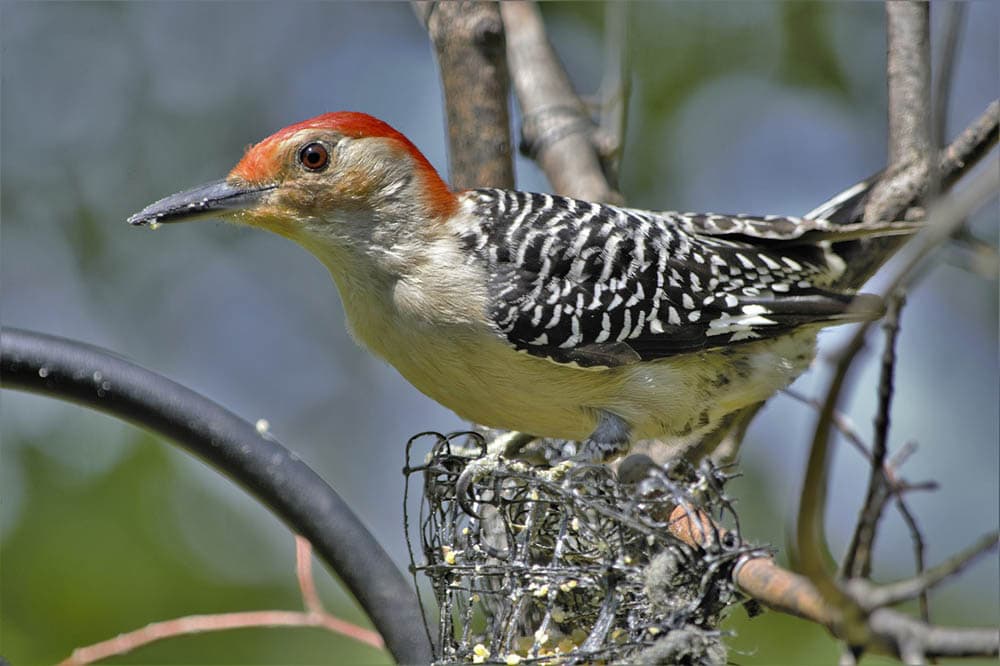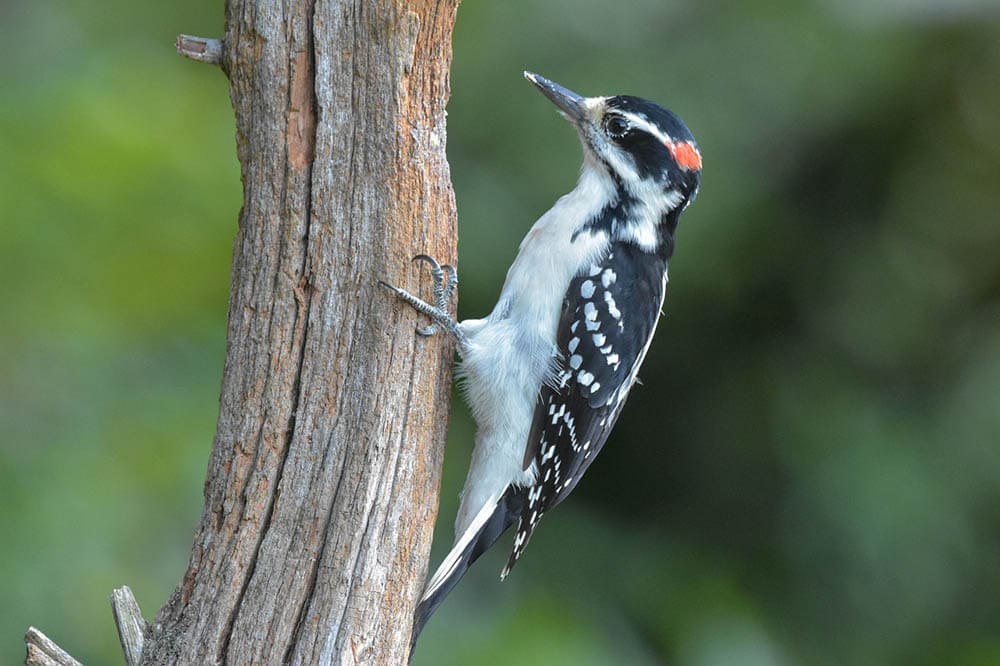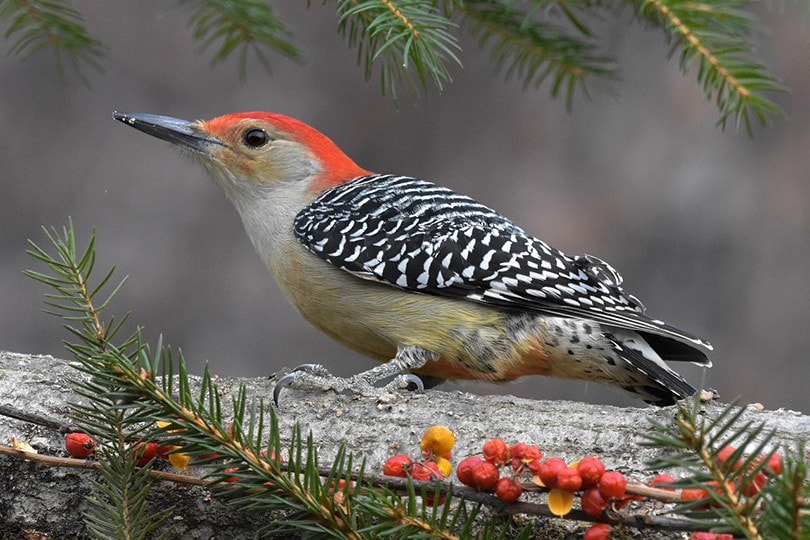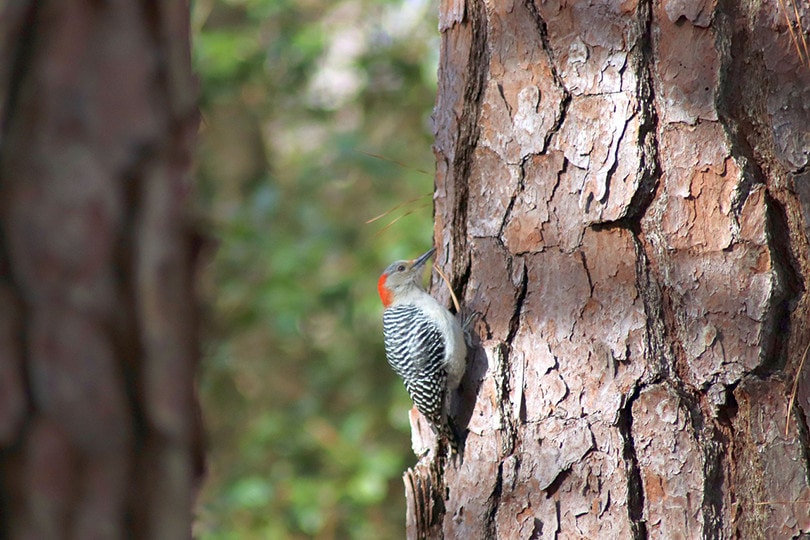8 Species of Woodpeckers in Alabama (With Pictures)
Last Updated on

Alabama is in the top five most biologically diverse states in the US and is number one among states east of the Mississippi River. Part of that biodiversity includes over 150 species of native birds. One of the most common types of birds in Alabama is the woodpecker; there are eight species in the state. In fact, woodpeckers are so common in Alabama that the state bird is a member of the woodpecker family.
You can recognize that you have a woodpecker near your home by a knocking sound coming from a tree. This sound is caused by them drumming their beaks against the bark of the tree in order to drill holes and look for insects. But, once you know you have a woodpecker, you may be curious as to what kind it is.
In this article, we’ll take a closer look at the different woodpeckers that live in the state of Alabama. We’ll also look at their characteristics, size, and coloration so that you can identify them more easily.
The 8 Species of Woodpecker in Alabama
1. Downy Woodpecker

| Scientific Name: | Dryobates pubescens |
| Length: | 7-6.7 inches |
| Diet: | Insects and seeds |
Downy Woodpeckers are the smallest species of woodpecker in Alabama and in North America. They are also one of the most commonly seen woodpeckers as they often visit backyards, parks, and anywhere else where there are plenty of trees.
You can recognize Downy Woodpeckers by their black and white checkered backs with white bellies. They have a white stripe above and below their eyes and males have a red patch on the back of their heads. Downy woodpeckers not only forage on the main trunks of trees but also on smaller branches. You can attract them with suet bird feeders in your yard.
2. Hairy Woodpecker

| Scientific Name: | Dryobates villosus |
| Length: | 9-11 inches |
| Diet: | Insects and seeds |
Hairy Woodpeckers look very similar to Downy Woodpeckers and the two are often confused for each other. However, Hairy Woodpeckers are slightly larger and aren’t as common as Downy Woodpeckers. They’re more common in forests than they are in backyards and parks.
Hairy Woodpeckers can also be identified by their beaks, which are slightly bigger than the Downy Woodpecker, although they have a coloration that is almost identical. They are more likely to be seen foraging on tree trunks and larger branches.
3. Northern Flicker

| Scientific Name: | Colaptes auratus |
| Length: | 12-14 inches |
| Diet: | Insects, fruits, berries, seeds |
The Northern Flicker is more commonly known in Alabama as the Yellowhammer due to the yellow coloration under its tail and wings that can be seen while the bird is in flight. Northern Flickers are the state bird of Alabama and Alabama is nicknamed ‘The Yellowhammer State’ due to how widespread and common these birds are throughout the state.
Other distinguishing features are brown and black barring on their backs, white bellies with black spots, gray crowns, and red spots at the base of their heads. Although they are woodpeckers, they can mostly be seen foraging on the ground rather than in trees. Suet provides a good backyard feeder diet for these birds.
4. Pileated Woodpecker

| Scientific Name: | Dryocopus pileatus |
| Length: | 15-17 inches |
| Diet: | Insects, fruits, and nuts |
Due to deforestation that took place in the 18th and 19th centuries and caused a sharp decline in their population, Pileated Woodpeckers aren’t as common as they once were. They’re gradually making a comeback though and are said to be the largest woodpecker species in Alabama.
Their bodies are mostly black with white stripes on their necks and white patches on their wings. The crests on their heads are bright red, which makes them easy to spot in trees; however, they only live in heavily forested areas and rarely visit backyards and urban areas.
5. Red-Bellied Woodpecker

| Scientific Name: | Melanerpes carolinus |
| Length: | 9-11 inches |
| Diet: | Fruit, insects, acorns, nuts, and seeds |
Red-Bellied Woodpeckers are neither the smallest nor the largest woodpecker species in Alabama, but they are the most common. Because they have a red head and neck, they are often mistaken for red-headed woodpeckers, which are actually a different species.
Red-Bellied Woodpeckers also have a light red or pink belly in addition to their red heads, which is how they got their name. They also have black and white barring on their backs. Unlike other woodpeckers, red-bellied woodpeckers eat mostly fruit instead of insects, but they do store their food inside trees and other wood structures like other woodpeckers do. They can also be seen in both urban and rural areas.
6. Red-Cockaded Woodpecker
https://www.instagram.com/p/CWVeY7Kry8O/
| Scientific Name: | Dryobates borealis |
| Length: | Around 7 inches |
| Diet: | Insects, fruits, and pine seeds |
Red-Cockaded Woodpeckers are another small woodpecker species and they are the only endangered woodpecker species in Alabama. They aren’t as widespread across the state as other woodpeckers either, as they are only found in mature pine forests where they excavate cavities in pine trees.
Red-Cockaded Woodpeckers are named for the very small red patches that the males have on the sides of their cap, an area that is known as the cockade. Other features include black and white barring on their backs, a black cap, and white cheek patches that help them to be more distinguishable from other small woodpecker species.
7. Red-Headed Woodpecker

| Scientific Name: | Melanerpes erythrocephalus |
| Length: | 8-10 inches |
| Diet: | Insects, nuts, berries, seeds, fruit, eggs, small rodents |
Red-Headed Woodpeckers are probably the most unique species of woodpeckers in Alabama. They are named for their heads and necks that are solid red. Unlike other species of woodpecker in which only the males have the red coloring, both the male and female of this species have the red coloring. They also have a body that is solid black and white instead of having barring or spots.
They can also be identified by their solid black and white bodies instead of having black and white barring and spots like other species of woodpecker. And instead of foraging for insects in trees, red-headed woodpeckers prefer to catch insects while they are in mid-flight. Red-headed woodpeckers also prefer open spaces as opposed to wooded areas. They’ll eat pretty much any kind of birdseed as well as nuts and berries. Some may even eat tree bark.
8. Yellow-Bellied Sapsucker

| Scientific Name: | Sphyrapicus varius |
| Length: | 7-9 inches |
| Diet: | Insects, tree sap, berries, and fruit |
Yellow-Bellied Sapsuckers are the only woodpecker species on this list that don’t live in Alabama year-round. They are only found in Alabama in the late fall, winter, and early spring and they don’t breed here either. Like other woodpeckers, the Yellow-Bellied Sapsucker has black and white barring on its back along with two white stripes on its face and a red crest.
But the distinguishing features of this bird are its yellow belly and neck and the red chin in males (white in females). Even if you don’t see one, you can tell one has been there by the horizontal rows of holes that they make in trees to create sap wells.
Related Read: 8 Species of Woodpeckers in Florida (with Pictures)

In Conclusion
Alabama is home to eight different species of woodpeckers, including the state bird the Yellowhammer. Although most of these woodpecker species look similar to each other, they each have distinguishing characteristics that set them apart. Knowing the differences between them can help you more accurately identify one next time you see it, which is highly likely as they are very common all throughout the state.
Featured Image Credit: Scottslm, Pixabay
About the Author Savanna Stanfield
Savanna is a former science teacher who is now a full-time freelance writer currently living in the United States with her husband and daughter. Other members of her family include a long-haired chihuahua named Penny, three cats, and an aquatic turtle named Creek. In addition to writing, her passions include gardening, traveling, and protecting our wildlife and natural resources.
Related Articles:
Monocular vs Telescope: Differences Explained (With Pictures)
10 Types of Hummingbirds in Arkansas (With Pictures)
8 Types of Hummingbirds in Nebraska (With Pictures)
5 Types of Hummingbirds in Idaho (With Pictures)
3 Types of Hummingbirds in Mississippi (With Pictures)
8 Types of Hummingbirds in Kansas (With Pictures)
5 Types of Hummingbirds in West Virginia (With Pictures)
5 Types of Hummingbirds in Ohio (With Pictures)
